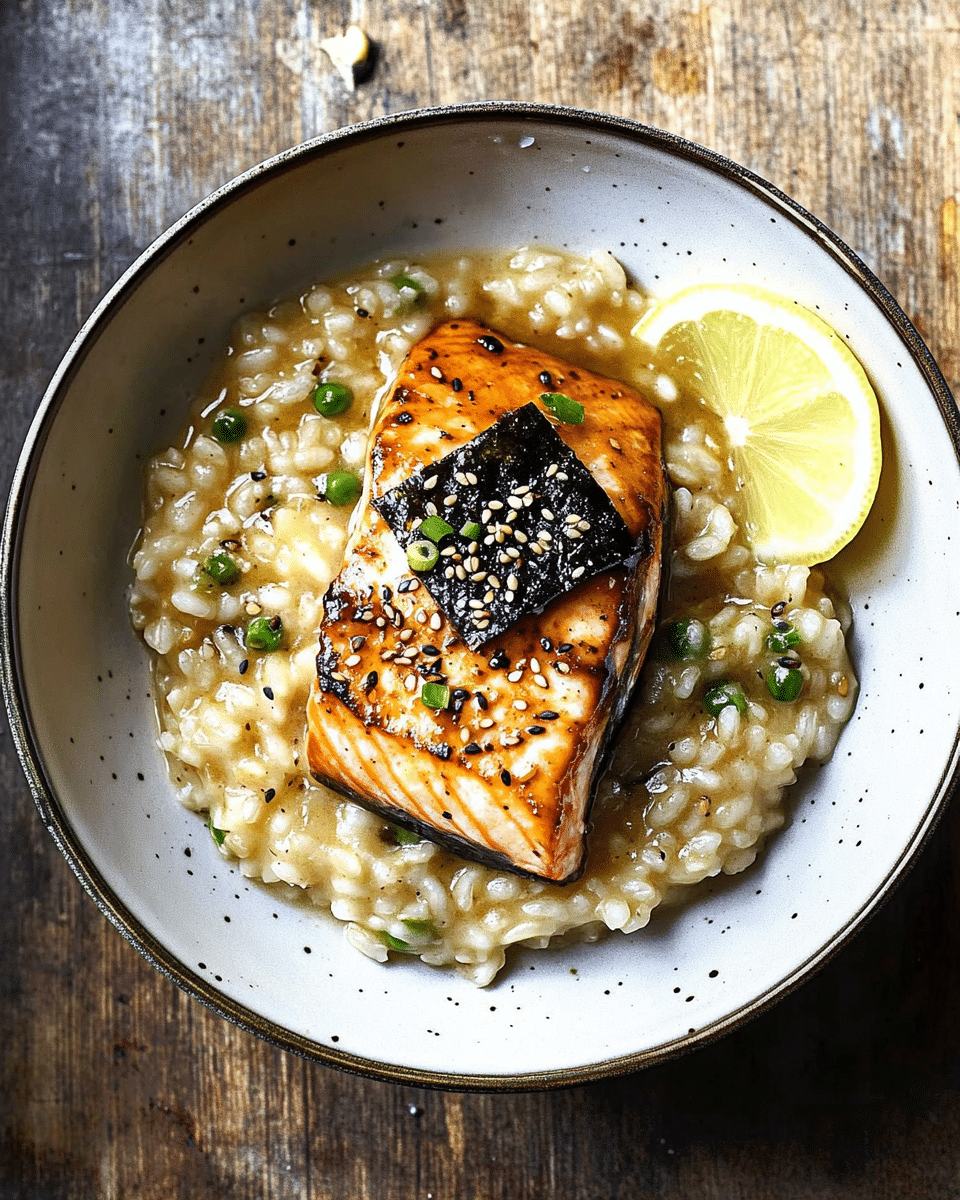The creamy texture of risotto combined with the umami depth of miso and dashi creates a comforting yet refined dish, complemented beautifully by the rich, seared salmon. Each bite carries the subtle complexity of Japanese flavors while delivering the cozy satisfaction of a classic risotto. This Japanese-Style Risotto with Seared Salmon is perfect for those evenings when you crave something nourishing yet special. It brings restaurant-level elegance to your dinner table without requiring complicated steps, making it ideal for a quick weeknight meal or an at-home date night when you want a dish that is both easy and impressive.
Full Recipe:
Ingredients:
-
2 salmon fillets, skin on
-
1 cup arborio rice
-
1 tablespoon white miso paste
-
4 cups dashi or vegetable broth
-
1 small onion, finely chopped
-
2 cloves garlic, minced
-
2 tablespoons soy sauce
-
1 tablespoon rice vinegar
-
1 tablespoon mirin
-
2 tablespoons unsalted butter
-
2 tablespoons vegetable oil
-
1 sheet nori, crumbled
-
2 green onions, finely sliced
-
1 tablespoon toasted sesame seeds
-
Freshly ground black pepper
-
Salt to taste
-
Lemon wedges for serving
Directions:
-
Warm the broth in a saucepan and keep it at a gentle simmer.
-
Season the salmon with salt and pepper. Heat 1 tablespoon vegetable oil in a skillet over medium-high heat, place the salmon skin-side down, and sear for 4-5 minutes. Flip and cook for another 2-3 minutes or until cooked to your liking. Set aside to rest.
-
In a separate large skillet or pot, heat the remaining oil and sauté the onion until translucent. Add garlic and cook for 30 seconds.
-
Add arborio rice and toast for 1-2 minutes, stirring frequently.
-
Stir in white miso paste, soy sauce, rice vinegar, and mirin. Add a ladle of warm broth, stirring frequently until absorbed. Continue adding broth one ladle at a time, allowing it to absorb before adding more, until the rice is creamy and al dente (about 18-20 minutes).
-
Stir in butter, half of the sliced green onions, and season with salt and black pepper.
-
Flake the salmon into large pieces.
-
Plate the risotto, top with flaked salmon, crumbled nori, remaining green onions, and toasted sesame seeds. Serve with lemon wedges.
Prep Time: 10 minutes | Cooking Time: 25 minutes | Total Time: 35 minutes
Kcal: 520 kcal | Servings: 2 servings
The Harmony of Italian Technique and Japanese Flavors
Few dishes embody comforting elegance like risotto. Known for its creamy, rich texture and the ability to absorb deep flavors, risotto traditionally leans on butter, wine, and Parmesan. However, when infused with Japanese culinary elements such as dashi, miso, soy, and mirin, this beloved Italian classic transforms into a bowl of umami-rich delight while maintaining its comforting heartiness.
The Japanese-Style Risotto with Seared Salmon celebrates the best of both worlds: the delicate, flaky richness of perfectly seared salmon paired with a creamy miso-infused risotto base, finished with nori and fresh green onions. This dish is not just a meal; it is a reflection of how global culinary traditions can merge seamlessly, bringing comforting yet refined flavors to your dinner table.
The Inspiration Behind Japanese-Style Risotto
In Japan, rice is a sacred staple that forms the backbone of daily meals, while dashi a stock made with kombu and bonito flakes builds a deep umami layer in countless dishes. By replacing traditional chicken broth with dashi and incorporating miso into the risotto, you enrich the rice with the depth and complexity found in Japanese home cooking while maintaining the risotto’s creamy texture.
Seared salmon is a natural pairing here, bringing healthy omega-3 fats and a buttery texture that complements the miso’s savory punch. Topping the dish with nori adds another layer of umami and a slight crispness, making every spoonful a satisfying combination of creamy rice, tender fish, and oceanic freshness.
Why You Will Love This Recipe
This recipe is perfect if you want:
-
A comforting, creamy dish with unique flavors.
-
A fusion meal that feels special yet is simple to prepare for weeknight dinners.
-
A nutritious option, combining protein-rich salmon with a satisfying rice base.
-
A restaurant-style dish that can be prepared without advanced techniques.
-
An introduction to Japanese ingredients like miso, mirin, and nori without feeling intimidated.
It is also easy to customize:
-
Use vegetable dashi for a pescatarian-friendly dish.
-
Add seasonal vegetables like snap peas, mushrooms, or baby spinach for texture and added nutrients.
-
Replace salmon with seared tuna or miso-glazed cod for variation.
The Role of Miso and Dashi in Flavor Development
Miso, a fermented soybean paste, offers a salty, slightly sweet depth, adding body to the risotto without the need for heavy cream or cheese. It creates a silky, savory backbone that allows the rice to shine while adding layers of complexity.
Dashi, often made with kombu (kelp) and bonito flakes, introduces subtle smokiness and oceanic notes that accentuate the seafood component while lifting the rice with an umami richness that water or plain vegetable broth cannot replicate.
Together, miso and dashi transform your risotto from a typical creamy rice dish into a bowl of layered umami comfort.
The Importance of Technique: Creamy Yet Light
Risotto’s creamy consistency comes from the slow incorporation of warm liquid into the rice while stirring frequently, allowing the starches to release gradually. In this Japanese-style version, using dashi instead of a heavier stock keeps the dish feeling light on the palate while retaining its creamy nature.
The addition of butter at the end ensures a glossy finish, while the fresh green onions and crumbled nori bring brightness and a gentle crispness that balances the creamy rice.
The Art of Perfectly Seared Salmon
Salmon plays a vital role in this dish, providing protein and luxurious texture. Searing the salmon skin-side down in a hot pan allows the skin to crisp up while maintaining the interior’s tenderness. This textural contrast enhances the risotto’s creaminess, ensuring each bite includes crispy salmon skin, tender flakes of fish, and creamy rice.
Resting the salmon briefly after cooking ensures the juices redistribute, keeping it moist while allowing for easy flaking over the risotto.
Health Benefits of This Dish
While risotto is often seen as indulgent, this Japanese-style risotto with seared salmon is a balanced, healthful meal:
-
Salmon is rich in omega-3 fatty acids, high-quality protein, B vitamins, and antioxidants.
-
Miso provides beneficial probiotics that support gut health.
-
Dashi is low in calories but rich in minerals and umami.
-
Using arborio rice ensures the dish remains satisfying while being naturally gluten-free, making it suitable for those with dietary restrictions.
-
You can add seasonal greens for extra vitamins, minerals, and color.
Serving Suggestions
For a complete meal, serve your Japanese-Style Risotto with:
-
A crisp cucumber and wakame salad with rice vinegar dressing for freshness.
-
Lightly steamed edamame sprinkled with sea salt for added protein.
-
A cup of green tea or iced matcha to complement the dish’s flavors.
Garnish with:
-
A squeeze of lemon for acidity.
-
Extra nori flakes or furikake for additional umami and texture.
-
Microgreens for a vibrant finish.
Storing and Reheating
While risotto is best enjoyed immediately, you can store leftovers in an airtight container in the refrigerator for up to 2 days. To reheat:
-
Add a splash of warm dashi or water to loosen the risotto.
-
Reheat gently on the stovetop while stirring until warmed through.
-
Flake additional fresh salmon on top if desired, or lightly sear leftover salmon to revive its texture.
Tips for Success
-
Warm your broth before adding it to the rice to maintain even cooking.
-
Stir frequently but gently to prevent sticking while encouraging creaminess.
-
Do not rush the broth addition; let each ladle absorb before adding the next.
-
Taste frequently to ensure the rice is cooked al dente, not mushy.
-
Use good-quality salmon for best flavor and texture.
Conclusion:
Japanese-Style Risotto with Seared Salmon is a dish that demonstrates the beauty of fusion cooking done thoughtfully. It honors the Italian technique of creating creamy risotto while showcasing the umami flavors of Japanese ingredients, making it both comforting and sophisticated.
Whether you are a seasoned home cook looking to experiment with Japanese flavors or a beginner seeking an impressive yet manageable dish, this recipe will quickly become a go-to for your meal rotation. It provides warmth on cold evenings, elegance for a special dinner, and the satisfaction of a nourishing, well-balanced meal.
By trying this recipe, you will discover how versatile risotto can be and how seamlessly Japanese ingredients can integrate into your Western cooking repertoire. Pair it with a simple salad or a warm bowl of miso soup, and you have a complete, satisfying dinner that will leave everyone at your table asking for seconds.






